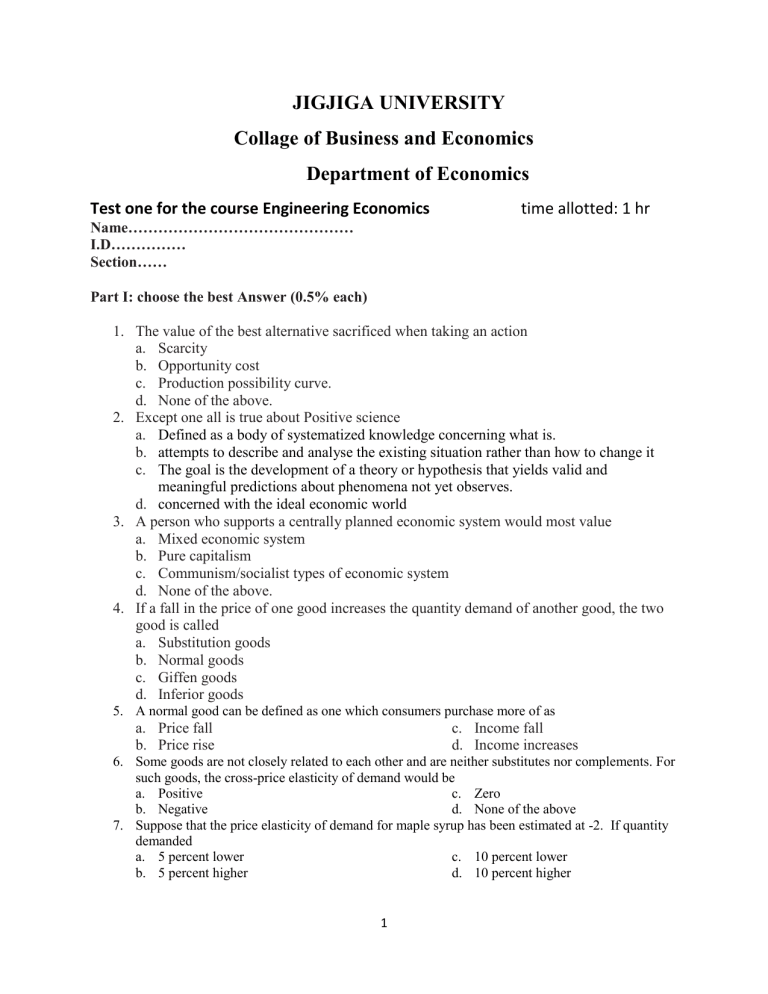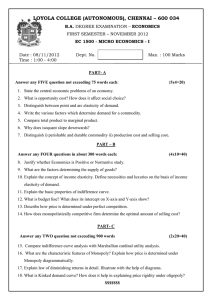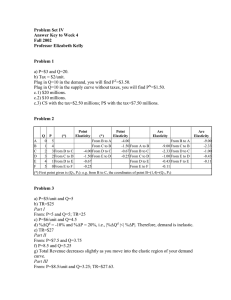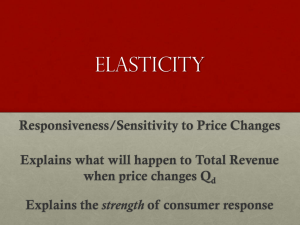Engineering Economics Test - Jigjiga University
advertisement

JIGJIGA UNIVERSITY Collage of Business and Economics Department of Economics Test one for the course Engineering Economics time allotted: 1 hr Name……………………………………… I.D…………… Section…… Part I: choose the best Answer (0.5% each) 1. The value of the best alternative sacrificed when taking an action a. Scarcity b. Opportunity cost c. Production possibility curve. d. None of the above. 2. Except one all is true about Positive science a. Defined as a body of systematized knowledge concerning what is. b. attempts to describe and analyse the existing situation rather than how to change it c. The goal is the development of a theory or hypothesis that yields valid and meaningful predictions about phenomena not yet observes. d. concerned with the ideal economic world 3. A person who supports a centrally planned economic system would most value a. Mixed economic system b. Pure capitalism c. Communism/socialist types of economic system d. None of the above. 4. If a fall in the price of one good increases the quantity demand of another good, the two good is called a. Substitution goods b. Normal goods c. Giffen goods d. Inferior goods 5. A normal good can be defined as one which consumers purchase more of as a. Price fall b. Price rise c. Income fall d. Income increases 6. Some goods are not closely related to each other and are neither substitutes nor complements. For such goods, the cross-price elasticity of demand would be a. Positive c. Zero b. Negative d. None of the above 7. Suppose that the price elasticity of demand for maple syrup has been estimated at -2. If quantity demanded a. 5 percent lower c. 10 percent lower b. 5 percent higher d. 10 percent higher 1 8. The income elasticity of an inferior good is a. Negative because as people get richer they increase their purchases of the good by smaller and smaller amounts. b. 1 because the increased income offsets the desire to consume less of the good because it is inferior. c. Greater than 1 because the richer you get, the less you consume of the good. d. Negative because higher income leads to a reduction in the amount consumed of the product. 9. Which of the following is likely to have the most elastic demand? a. A good with a vertical demand curve b. Cigarettes c. All types of soda pop d. Sprite e. Life sustaining pills 10. Labor, human capital, entrepreneurship and capital all are the examples of? a. Public goods b. Inferior goods c. Factors of production d. Output e. Substitution in production 11. A curve showing all combinations of two goods that can be produced with the resources and technology currently available. a. Production possibility curve b. Public goods curve c. Indifference curve d. None of the above 12. the study of the behavior of individual households, firms, and governments; the choices they make; and their interaction in specific markets a. financial economics c. macroeconomics b. microeconomics d. international economics 13. If consumers spend $15 million a month on CDs, regardless of whether the price they pay goes up or down, a. 0 b. 1 c. Infinitive d. 15 e. None of the above 14. Which of the following will not be a determinant of the price elasticity of demand for a commodity? a. The absence of substitute for the good. b. The presence of substitutes for the good. c. The importance of the commodity in consumers’’ budgets. d. The length of time period to which the demand curve pertains. e. The cost of producing the commodity. 15. The arc elasticity formula is used to estimate elasticity when a. The product is thought to be inelastic. b. The product is thought to be elastic. c. The demand function is known. d. There are two observations of price and quantity. e. None of the above. 2 Part II: short discussion (select three questions 2.5 % each) 1. List and explain the determinants of demand 2. Try to discuss in detail the advantages and disadvantages of free market economic system 3. The demand curve for an inferior good is upward sloping.” True or false? Explain. 4. Discuss in detail on the factors that can shift the production possibility frontier. Part III: work out (5%) 1. The demand for bottled water in a small town is as follows Price per bottle Quantity 1.00 500 1.50 400 2.00 300 2.50 200 3.00 100 Determine a. Calculate the price elasticity of demand for bottled water for a price rise from $1.00 to $1.50? Is demand elastic or inelastic for this price change? b. Calculate the price elasticity of demand for a price rise from $2.50 to $3.00. Is demand elastic or inelastic for this price change? 3







